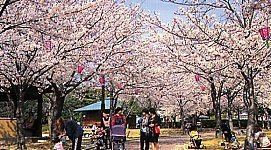Country Japan Phone number 0566-41-3311 Population 70,520 (May 2015) | Area 37.17 km² Local time Sunday 6:20 PM | |
 | ||
Weather 11°C, Wind NW at 29 km/h, 57% Humidity Points of interest Hekinanshi Akashi Park, Hekinanshi Rinkai Park, Hekinan Seaside Aquarium, Kumano Shrine | ||
Hekinan (碧南市, Hekinan-shi) is a city located in Aichi Prefecture, Japan. As of May 2015, the city had an estimated population of 70,520 including 3,227 foreigners. and a population density of 1900 persons per km². The total area was 37.17 square kilometres (14.35 sq mi).
Contents
- Map of Hekinan Aichi Prefecture Japan
- Geography
- Surrounding municipalities
- Climate
- History
- Politics
- City council
- Economy
- Industry
- Agriculture
- High schools
- Middle Schools
- Elementary schools
- International schools
- Transportation
- Railway
- National Route
- Prefectural road
- Twin towns Sister cities
- Local attractions
- Festivals
- Noted people from Hekinan
- References
Map of Hekinan, Aichi Prefecture, Japan
Geography
Hekinan is located in south-central Aichi Prefecture, and is surrounded by Lake Aburagafuchi, the Yahagi River, Kinuura Bay, and Mikawa Bay. Most of the city area lies on reclaimed ground, with an average elevation of under seven meters above sea level. The majority of people live in the center of the city. Factories, farms, and harbors occupy the coast.
Surrounding municipalities
Climate
Gamagōri, Aichi is the closet point that measures climate information.
History
Hekinan was established on April 5, 1948 by the merger of the towns of Ohama, Shinkawa and Tanao, and the village of Asahi. As it is located on the southern (南) part of Hekikai District (碧海郡), the city was named Hekinan (碧南). Hekinan was the tenth city founded in Aichi Prefecture. Since it had harbors and rails, the city developed quickly after Pacific War. On April 1, 1955, one part of the village of Meiji, which is currently called Nishibata, was incorporated into Hekinan. On September 26, 1959, Typhoon Vera also known as the “Isewan Typhoon” heavily damaged the city. On July 14, 1974, Rinkai Kōen Pool or also known as Kinuura Mammoth Pool was opened. Because the city reclaimed the seaside for industrial purposes in 1960's, Hekinan opened this pool for people who complained about losing their beautiful beach. On May 23, 1988, Hekinan Municipal Hospital was opened. In 1993, Hekinan Thermal Generating Station was created by Chubu Electric Power on the reclaimed ground. This provides high tax revenue to the city. On August 17, 2003, since the facility of the Rinkai Kōen Pool became old and the number of the visitors of the pool was reduced, the city shut down the pool. Instead, the city created Hekinan Rinkai Park on the same place.
Politics
Hekinan is one of the wealthiest cities in Japan. Its financial capability index is 1.70. This is because the city has Hekinan Thermal Generating Station, which is one of largest thermal power plants in the world.
City council
The number of representatives is 26. It is considerably high compared with other cities of similar size.
Economy
Cars, metal, tile, and foods are the main industries in the city. In 2006 the number of factories was 463 with 16,778 workers. The value of shipments was 84,356,533 million yen in total in 2006.
Industry
As Hekinan is located in Aichi, Hekinan's main industry is manufacturing automotive parts. In 2010, there were 9,148 people working in this industry, shipping products worth 47,058,959 yen which is more than half of the amount of shipments in the city. Toyota Industries is the biggest company for the industry in the city. There were 1,722 Toyota employees in Hekinan, or about 10% of the total industrial workers in the city in 2010.
One remarkable industry in the city is related to ceramic roofing tiles. Hekinan is one of the cities that produce Sanshu kawara, a well-known regional brand. In Japan, 58 per cent of tiles, which is about 50,000,000 tiles, are Sanshu kawara.
Agriculture
Even though only 4% of the population of Hekinan engage in agriculture, one-quarter of the area is farmland. The main products are carrots, onions, potatoes and figs. Anjo and Hekinan are the largest producer of figs in Japan.
High schools
Middle Schools
Elementary schools
International schools
Transportation
Toyota, as the home city of Toyota Motors is well-served by expressways and national highways. However, it is the largest city in Japan which was not served by the Japanese National Railways (JNR), or its successor, JR Central. The closest Shinkansen station is Mikawa-Anjō Station in the city of Anjō, although the limited-stop Nozomi and Hikari services do not stop there.
Railway
National Route
Prefectural road
Twin towns — Sister cities
Hekinan is twinned with:
In April, 2005, the Deputy Prime Minister of Croatia visited to Hekinan in order to participate Expo 2005. During the stay, the Vice Prime Minister proposed to have sister cities relationships between Croatian cities. Hekinan sent officials to Pula in 2006. On April 5, 2007, Hekinan invited the Mayor of Pula for 59th anniversary and established the sister city relationship between the two cities.
In order to build Hekinan citizen's international sensibility, the city was looking for a sister city relationship with a city in the Pacific Ocean coast. At the same time, Edmonds considered to have the relationship with one of Japanese cities. Edmonds sent officials to Hekinan in 1986. The two cities start exchanging people for home stay. Two years later, at the ceremony of 40th anniversary of Hekinan, the two cities established the sister-cities relationship.
Events between Hekinan and EdmondsAbout 20 people from Hekikaigun moved to Yuni, Mikawa. Since the sounds of the regions were the same, they developed this region very well. This connection made two cities have the sister city relationship at the same date that Edmonds signed the relationship between Hekinan.
Local attractions
Festivals
Various festivals are held throughout the year in Hekinan.
